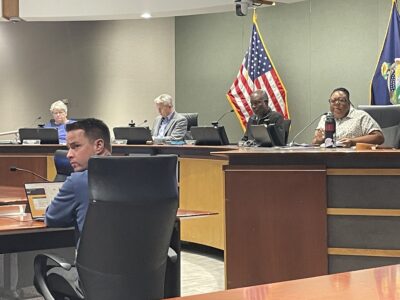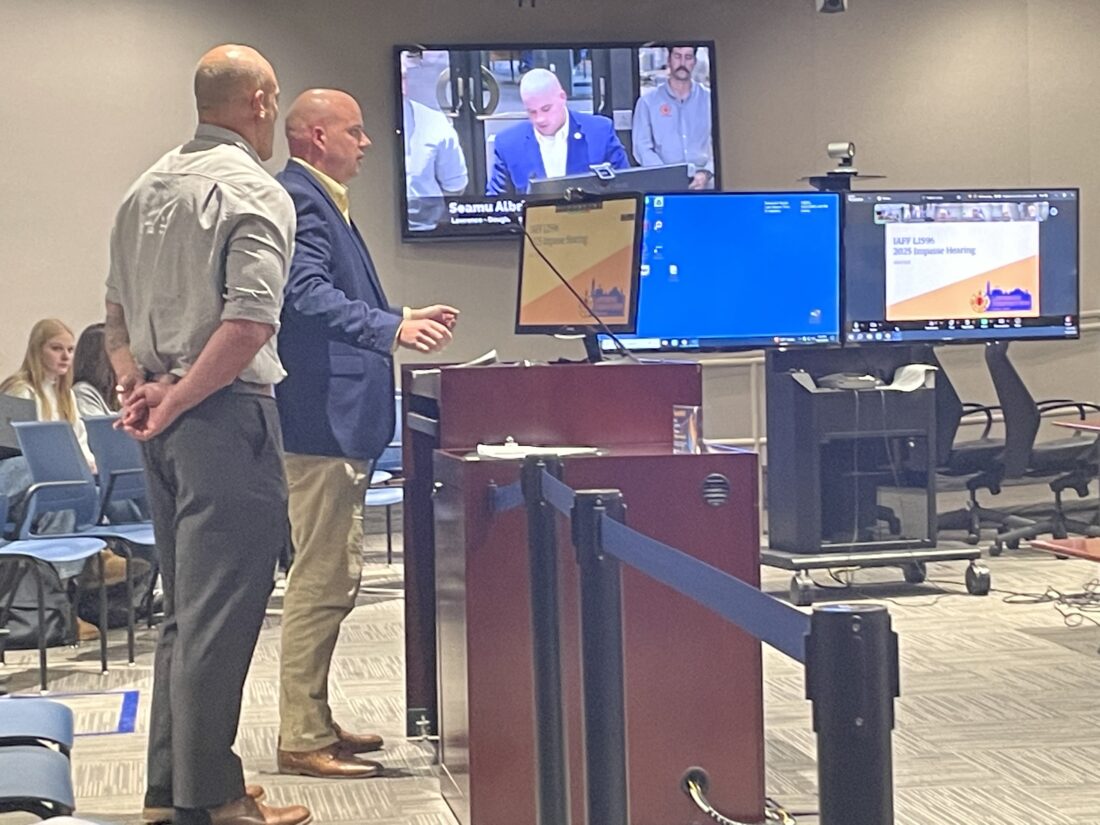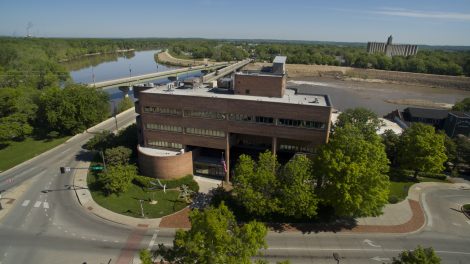Lawrence City Commission sides with city’s pay proposal in impasse with fire medical union

photo by: Sylas May/Journal-World
Lawrence city commissioners discuss proposals for fire and medical pay on Tuesday, Oct. 21, 2025.
Citing the “sacrifices” that the city has had to make in a difficult budget year, the Lawrence City Commission on Tuesday broke an impasse between the city and the fire medical union by siding with the city’s pay proposal.
The commission voted 3-1, with Commissioner Amber Sellers opposed and Commissioner Brad Finkeldei absent, to accept management’s proposal, which includes a 3% general wage increase for LDCFM employees. As the Journal-World reported, the union was proposing a 4% pay increase at the start of the year and an additional 2% increase partway through the year, and a neutral fact-finder had suggested a 4.5% pay increase.
Both city staff and the International Association of Fire Fighters Local 1596 union presented information about the proposals to the commission on Tuesday. But union leader Seamus Albritton said the union was “attempting to be reasonable” and was presenting what the fact finder had recommended.
“We’re willing to be flexible and reasonable and take what a third party … has offered,” Albritton said.
Megan Dodge, the city’s human resources director, meanwhile, said that the city’s proposal was informed by budget concerns, comparisons to peer agencies and the Consumer Price Index.
“We felt that our proposal is fair,” she said, “… using the CPI as one of the factors.”

photo by: Sylas May/Journal-World
Union leader Seamus Albritton, right, addresses the Lawrence City Commission about proposals for fire and medical pay on Tuesday, Oct. 21, 2025.
Albritton said that he was “not here to bang my fist on the table,” and that he was still proud to be employed in the Lawrence department. However, he also disagreed with some of the city’s decisions, including how it characterized LDCFM’s peers. LDCFM is an ambulance service in addition to a fire department, while many of the peers are not, he said, and “we’re not necessarily compensated for standing out like that.”
“We are performing in the top 50% of the market, but we are being compensated at the bottom 50% of the market,” he said. “That is not equitable.”
A few members of the union addressed the commission during public comments, urging the commission to support higher wages. Union member Eric Lynch said his fellow emergency personnel were “the hardest-working people I know,” and that the city should not add to “our growing list of issues” with public safety.
“At the very least, pay our firefighters what they deserve,” Lynch said.
Commissioner Bart Littlejohn said he was comfortable staying with the city’s proposal of 3%. He said that during the budget process, when the city faced a more than $6 million budget hole, “we asked everyone to make sacrifices, and everyone did.” And he pointed to the city’s decisions on fire and medical staffing during the budget process, as well as the city’s efforts to add a new fire station.
“It’s not like we haven’t shown that we value and support the IAFF,” Littlejohn said.
Sellers also pointed to the budget process and said she’d seen city leaders “back ourselves into a corner year after year after year.” She said the commission had “hamstrung” itself by setting the mill levy at “a smaller number, which we then shrunk even more.”
She said that if residents wanted more spending on public safety, there were costs involved in that.
“They want public safety, and I’ve said it before: Today’s price is not yesterday’s price,” Sellers said.
The commissioners did not necessarily have to make an either-or decision between the city’s proposal or the union’s. They could have tweaked the proposals or used the proposal of the neutral fact-finder, mediator Stephen Douglas Bonney, who found that pay for the firefighters and other emergency personnel did lag behind the peer agencies.
In his report, Bonney wrote that some employees faced a larger gap than others. Drivers, for instance, made about 80% of the market median, but other employees had pay between 91.7% and 98% of the market median, Bonney wrote.
Bonney had also recommended that so-called “step” increases, where employees move up on the pay scale, be moved to the beginning of the year, something that was also in the city’s plan that the commission accepted. The union had wanted to keep the “step” increases the way they were, which would give employees their adjustments on the anniversary date of their hiring.
Mayor Mike Dever said that even though the fact finder had to do a lot of work to produce the report and recommendations, the commission still had to make its decision in accord with its financial responsibilities.
“I know that the fact finder had a lot of decisions to make,” Dever said. But he added that “The fact finder does not have fiduciary or financial concerns… or any budgetary constraints whatsoever.”
Dever said he understood what the firefighters union was saying about its compensation..
“I acknowledge there’s a gap, and I’m sorry there’s a gap,” Dever said.
But he also said that “we asked everyone to cut this year.” And of the 3% increase, he said the reason for it was “A. that’s what we can afford, and B: that’s what we can afford.”
This is not the first time the commission has had to break a deadlock between the city and the firefighters union. In 2019, the two sides couldn’t reach an agreement after a long period of mediated negotiations, and the commission chose to adopt the union’s proposal over the city’s, as the Journal-World reported.
In other business, the commission:
• Received a request for tax incentives for a proposed affordable housing project at Bob Billings Parkway and K-10. The development, known as Floret Hill, would create 121 permanently affordable rental units and would also include 12 affordable townhome units for purchase. It would also include a 1-acre commercial property to the north of the housing development.
In 2022, the project received a land donation from the city, and last year it got $1.3 million in affordable housing trust funds. But the developers say the land at the site has features that make it challenging to develop, and that labor and material costs have gone up. They are requesting a 100% property tax abatement for 10 years and a sales tax exemption on construction materials.
• Authorized an agreement for a Build Kansas grant to rehabilitate the apron and taxiway of Lawrence Regional Airport. This grant is for roughly $28,000, and the city will use it to help pay its share of a federal matching grant under the Bipartisan Infrastructure Law. The federal grant would be for about $568,000 and would require the city to provide $29,924 in matching funds.
The commission also approved a $774,000 contract for a taxiway lighting project with Third Generation Electric. It will use money from the Airport Fund and State Grant Fund, according to a memo to the commission.
The airport-related items and receiving the affordable housing project’s incentive request were all on the commission’s consent agenda, a group of items that can be approved on a single vote.






